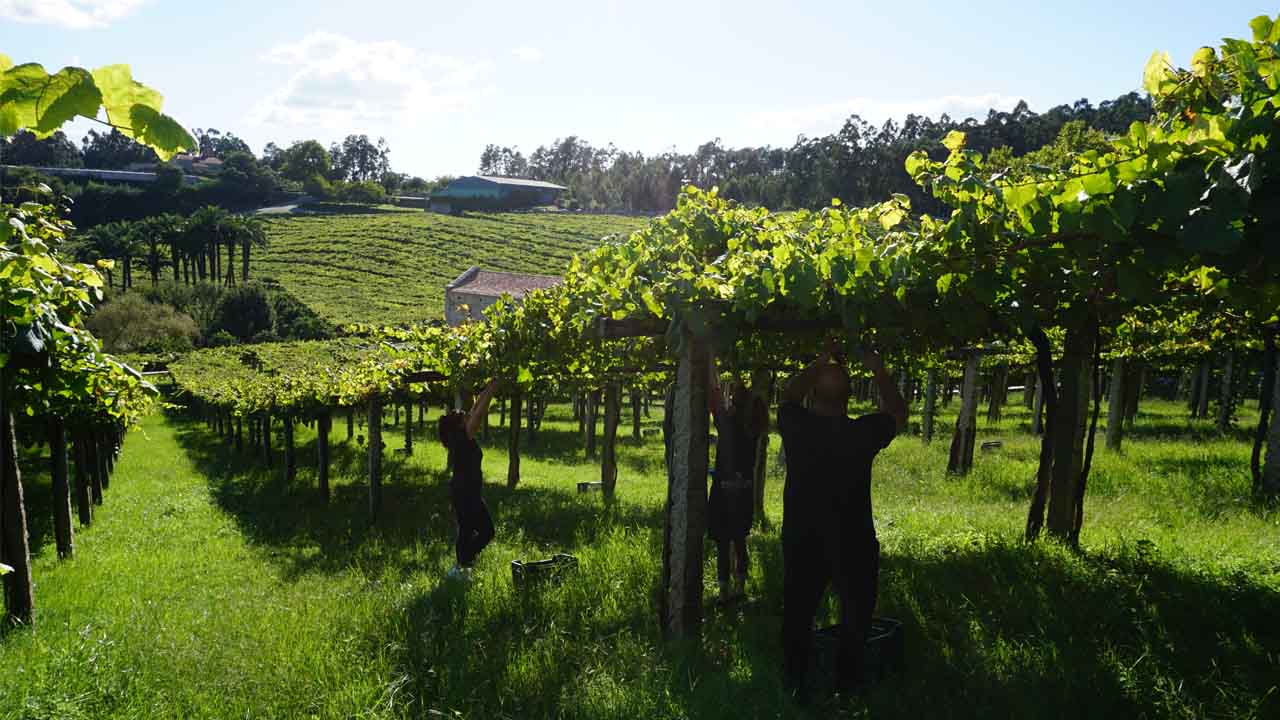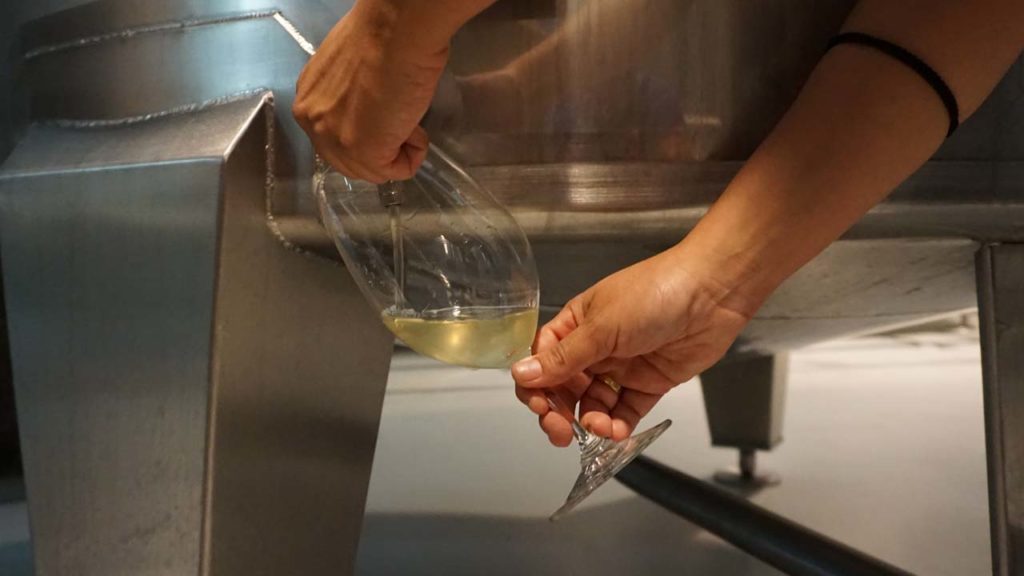

Care, selection, knowledge, dedication… The stages of the grape harvest at Pazo Baión are the result of a delicate process in which even the smallest details are taken care of
If Henry Ford had the opportunity to observe the stages of the grape harvest at Pazo Baión, he would surely smile. Few like him in history have so sublimated the strength of the collective. «Working together -the American businessman insistently repeated- is the road to success».
The success of Pazo Baión is indeed largely the result of a sum. Of effort, knowledge, dedication… And a lot of passion. Passion for making single-estate albariños of exceptional quality.
This shared journey reaches its maximum expression these days. It’s during the harvest when the property becomes a choral machine in which everyone knows what they have to do. And more importantly, how to do it.
To understand what happens these days at the estate, no one better than Andrea Obenza, Pazo Baión’s winemaker. She will be the one who will guide us to understand the stages of the grape harvest.
The beginning of everything. The starting point that will turn an exceptional raw material into 3 albariños, acclaimed by critics and the public alike.
Let’s go on this journey…
Goldsmith among vineyards
Grape harvesting at Pazo Baión is certainly a much more delicate process than in most wineries. Winemaker José Hidalgo puts it graphically: «We only have one bullet. And we can’t miss».
Indeed, Pazo Baión wines are made with grapes harvested exclusively on the estate. And that forces them to take extreme care of the vineyards throughout the year. There is no other option.
This high demand has led the enology and viticulture team to unravel the secrets of the 22 hectares of vineyards on the property. A deep knowledge that has triggered a unique phenomenon: the micro-harvest.
Obenza explains that, despite being a single plot, his team has divided it into sub-plots, each with its particularities. «It should not be forgotten that between the highest and lowest plots there are 50 meters of altitude, and that translates into half a degree of alcoholic difference and between a week and 10 days at the time of harvesting», she says.
But it’s not only in the altitude that there are singularities. Also in the properties of the soil. The lower areas of Pazo Baión have more organic matter and the higher ones are eminently mineral.
All this knowledge has been transferred to the winemaking processes. Perhaps the most graphic example is Vides de Fontán, which is made with grapes harvested from the highest plots of Pazo Baión.
Anyway, they are not all different. On the contrary, there is a common denominator in the first of the stages of the grape harvest: the care is taken when picking the bunches of grapes, regardless of the plot.

On the way to the sorting table
It’s then, with the grapes previously selected from the vineyards, that they are transferred to the sorting table. The second of the stages of the grape harvest is critical at Pazo Baión.
The winery’s winemaker describes it: «What we do at the table is to control very slowly all the clusters that will reach the macerators. We remove any leaves that may have fallen in the box, we remove any spoiled grapes or second harvest bunches. In this case, because not being ripe would give us too much acidity and we don’t want that».
This manual and delicate process represents a guarantee. A safety cushion to certify that the product that will enter the macerators is of the highest quality.
Aromatic precursors
Once the selection table has been passed, the raw material with which Pazo Baión white wines are made will go to the macerators. Imposing tanks in which the delicious grape must come together with a powerfully aromatic paste formed by the skins of the fruit.
At this point, it should be remembered that the albariño grape cluster has a singularity: it’s very small. The aromas, moreover, are concentrated in the skin, which is why at Pazo Baión it is used to give it such a characteristic aromatic power.
In the macerators, all the raw material (must and organic matter) will remain between 4 and 6 hours. A time that will allow the extraction of all the aromatic precursors that will ultimately give Pazo Baión albariños their fascinating personality.
We love the must…
The next stage of the grape harvest belongs to the purest winemaking process: the «defanged». «Here what we do is to remove the most solid parts of the must, the remains of pulp, and so on. Using the cold, they will fall to the bottom of the stainless steel isothermal tanks, which will leave us with a clean must», Andrea explains.
This process can take between 36 and 72 hours.
Discovering the wine
Once the grape juice has been cleaned, one of the most characteristic phases of winemaking is coming: fermentation. That catalytic function transforms the must into wine.
In short, the vinification process in which the nuances and aromas so characteristic of our albariño wines emerge. «For us, it’s very important to have a very clean must, so that we avoid the emergence of aromas that we are not looking for», she points out.
In the winery, fermentation also takes several paths. For example, the fermentation of Pazo Baión is carried out in stainless steel tanks, while in the case of Vides de Fontán, part of the fermentation is transferred to French oak vats.

Time to batonage
The next stage will be the batonage, or lees stirring. A journey in which the dead yeasts of Pazo Baión wines, their lees, are used to provide them with their aromatic power, a very visible feature also in Gran a Gran.
The winery’s enology team will stir these lees periodically. Once a week or every two weeks. «We will decide as we go along, depending on the evolution and the characteristics of the wine in the mouth», Obenza argues.
The duration of this process again depends on the label. Pazo Baión will remain between 4 and 6 months, while Vides de Fontán will have a longer period. One year on first lees and another year on second lees. This aging is essential to give it its recognizable personality.
Clarifying and bottling
Now there is only one phase left to shape the single-estate albariños. Clarifying the wine, stabilizing it, and then filtering it for bottling.
«The wine will remain in the bottle for some time until it is released on the market», concludes Andrea Obenza.
The miracle of winemaking will now have taken shape.
Access our wine-shop to buy the best albariño wine.
If you want to do wine tourism in the Rías Baixas, visit our winery.
Share
Access exclusive offers
Subscribe to our offers
Social media
Most viewed news


5 plans in the Land of Albariño for Easter Week

The albariño grape in 10 keys





